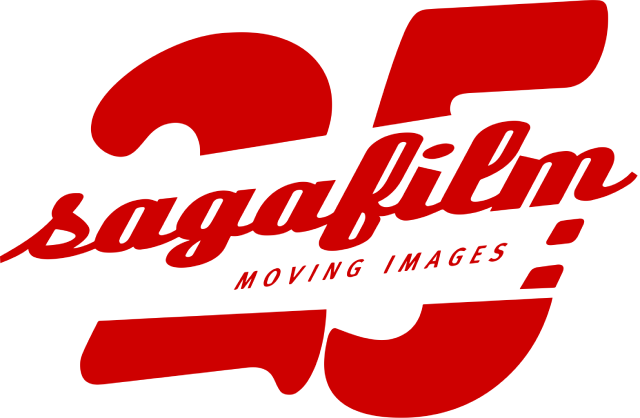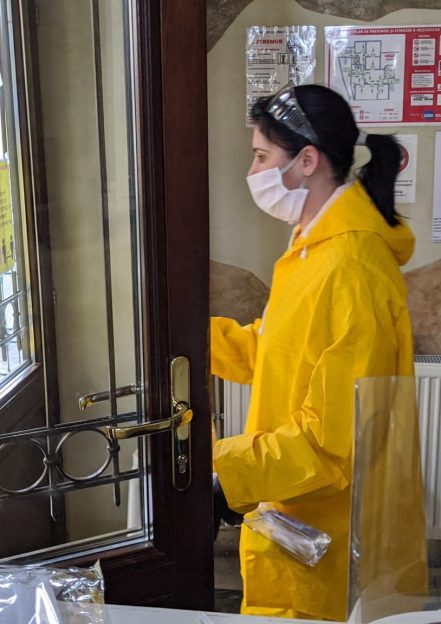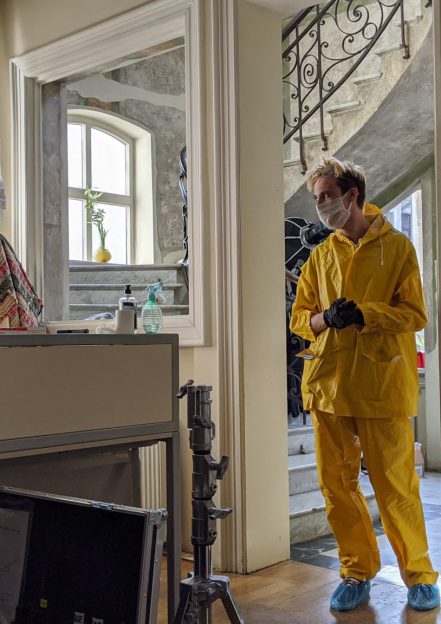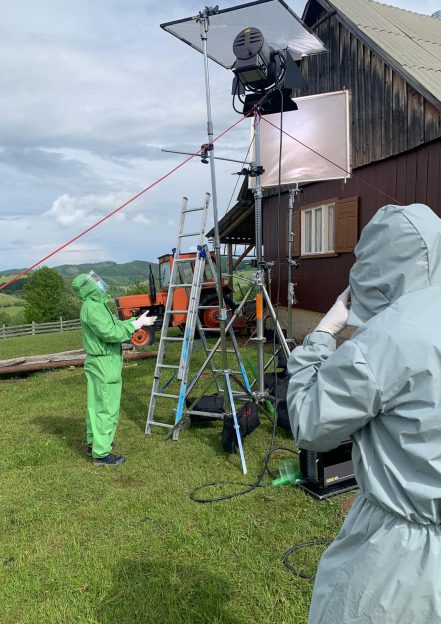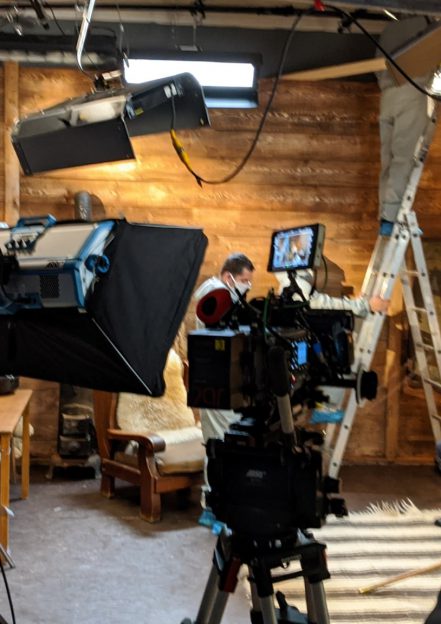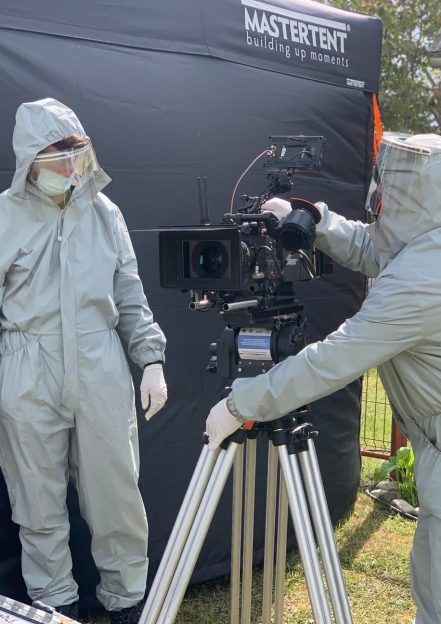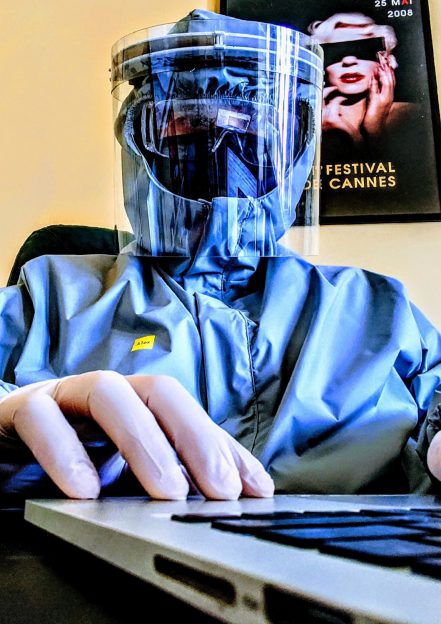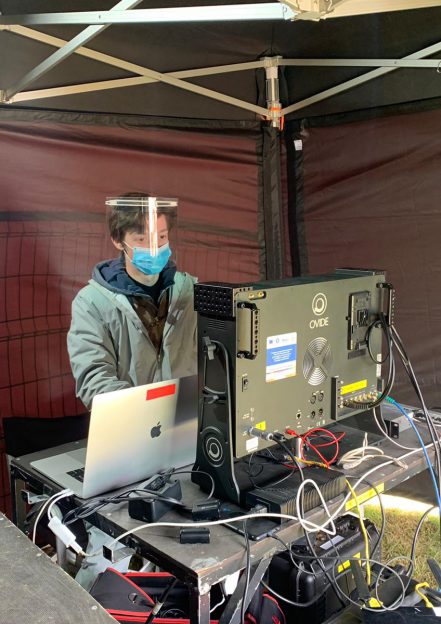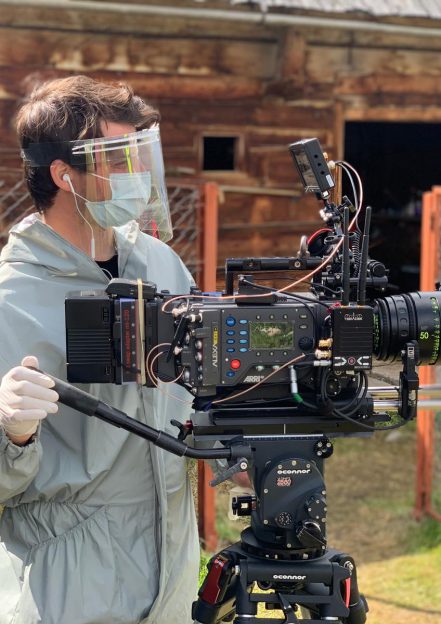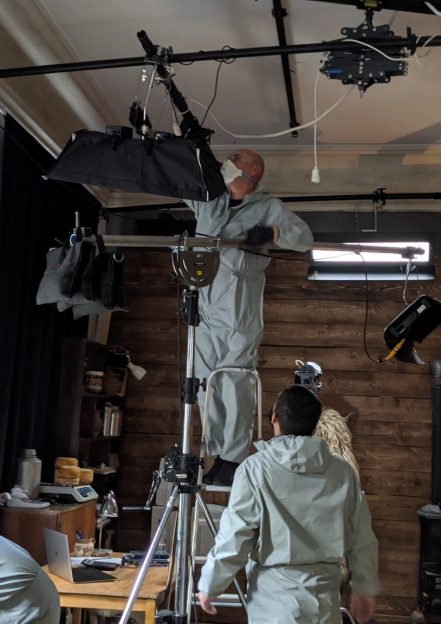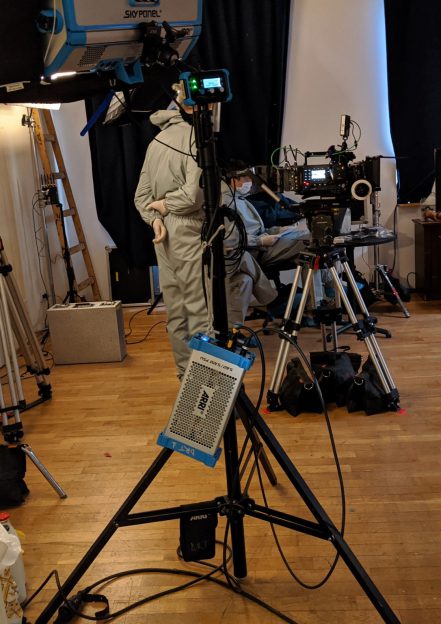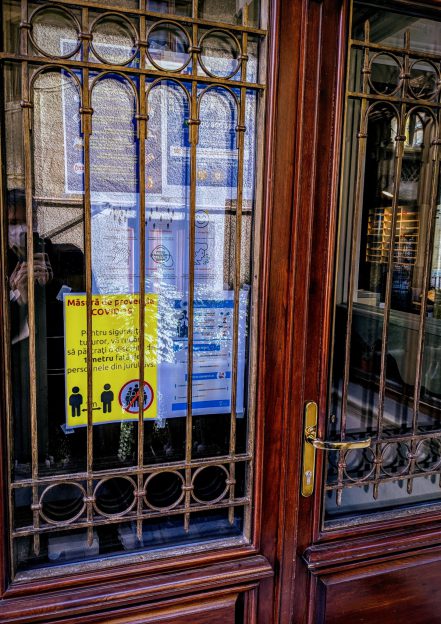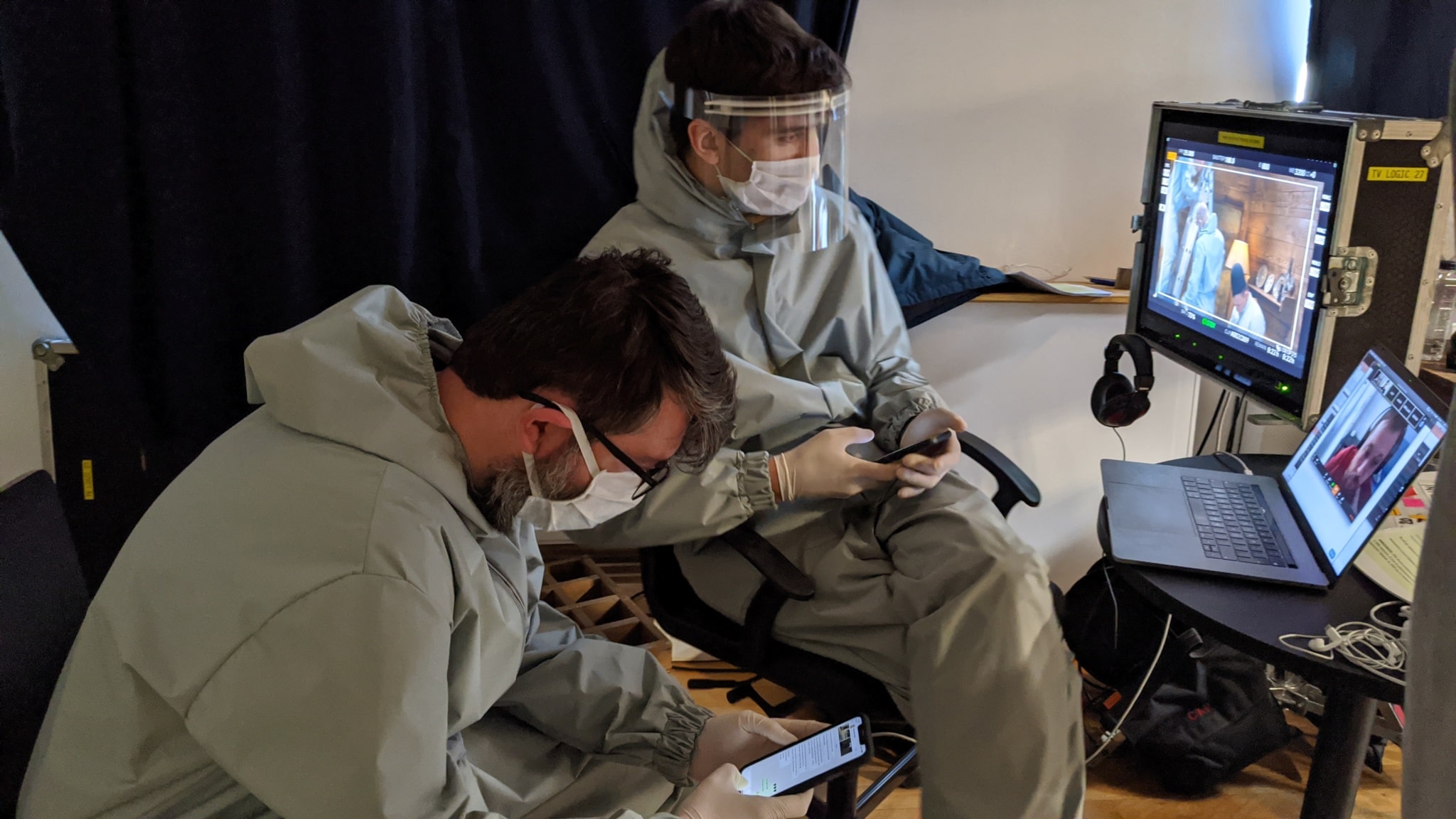
SECTION 1
MANDATORY REQUIREMENTS
As an employer, production companies must ensure that government guidelines are followed to reduce the risk of contamination by maintaining proper hygiene and enabling the necessary social distancing.
Maintaining social distance
It is necessary for people to be able to maintain a social distance of 1.5 meters while working.
Keeping the number of people on set at a minimum
The number of crew members must be kept to a minimum.
The agency and the client are also encouraged to send as few representatives as possible.
Arrival and entry times on set
To the extent possible – call times should be separated so that each department is given access at different time intervals to prevent crowding on the set.
Workflow optimization
The work should be coordinated so that a minimum of people have access to a space at any one time. For example – the electrical department should not start work until art department finishes and leaves the location.
Hygiene on set
All people on the set must follow the rules of the medical authorities in relation to hygiene and behave appropriately to minimize the risk of the disease spreading.
PERSONAL DISINFECTION – If the filmed scene is extended, crew members must carry disinfectant wipes in their pocket or a 30 ml bottle of personal disinfectant so that they do not have to leave during filming to reach the disinfectant stands.
DISINFECTANT STANDS – Disinfectant devices must be made available at points of entry and in common areas, ie near facilities, catering and directly on the set.
DISINFECTION OF OBJECTS – When filming in a public space in the city and in a place with a high concentration of people, it is recommended to consider disinfecting the space by spraying (especially for large productions).
FILMING IN VEHICLES etc. – Production should ensure the disinfection of all vehicles, as well as (as appropriate) vehicles carrying the crew and the cast.
WORKSHOP DISINFECTION – When filming outdoors, the make-up and costume department should disinfect their workstations and chairs for actors.
COSTUME DISINFECTION – Regular disinfection of costumes is important. The frequency with which disinfection is performed will depend on individual risk assessment.
MAKE-UP DISINFECTION – Make-up artists must have a separate set of makeup for actors and people, as well as separate for extras in scenes without actors. It is also necessary to wear masks and protective gloves. It is recommended to consider different make-up artists for actors and for extras.
Information on how to maintain proper hand hygiene should be provided to all people present on set – both in the form of official printed materials from the health authorities and as part of the morning briefing.
Cleaning requirements
Production is responsible for frequent cleaning of contact surfaces – this includes: door handles, surfaces, bathrooms and any equipment managed by more than one person.
Any workstation used by more than one person must be cleaned between each user.
As for the disease
Anyone exhibiting mild or severe symptoms of COVID-19 will not be allowed entry to set.
Dry cough, fever, muscle pain and sore throat are considered to be symptoms of COVID-19.
Information
Information regarding the risk of spreading COVID-19 and what behavior is expected from everyone on set is to be made visible in the common areas. This includes agency and client.
SECTION 2
INDIVIDUAL RESPONSIBILITY
Everyone on set has an individual responsibility to prevent transmission of COVID-19 by doing the following:
SECTION 3
PRACTICAL IMPLEMENTATION
Putting government guidelines for work environments into practice on film sets.
Scene Restrictions
ACTORS AND EXTRAS – They need to work in their own department, separate from each other, and wear face masks, except for the filming scene.
EXTRAS IN SCENES WITH ACTORS – The extras who interact in scenes with actors – where the frame requires a distance of less than 1.5m – must be separated from the rest of the extras.
Location Limitations
If a scene is filmed in a small space (less than 20m2), only the following people can access it during filming:
• Camera Operator
• Focus Puller
• Sound Recordist
Production must provide remote viewing possibilities for all other people.
Masks must be provided at all times when social distancing measures are difficult to maintain consistently as a result of a confined filming space.
Filming in both public and closed spaces must not exceed a number of 50 people. In enclosed spaces, the individual space must be of 4mp2 for each person, and during an interaction, the space between each person involved must not exceed 1.5m.
Craft & Catering
It is necessary to take into account – especially in the first months – of requirements for multiple space areas during the use of locations in a public space, so that crew members can be separated. At the same time, there must be enough space to allow the crew to eat at the recommended distance of 1.5m from each other. The use of portable chairs instead of standard basecamp benches is favored.
Buffet meals are not allowed. All meals should be served as single portions – and distributed so as to avoid contamination of surfaces. It is necessary to make sure that the food can be distributed in a take-away manner.
All drinks must be in single containers, ie water bottles and cans.
None of the following is allowed.
– Self-service coffee station
– Snacks bowls or unpackaged food.
– Fruits that are not individually packaged.
Meals should be arranged at two intervals of 20 minutes each.
Anyone who handles food should wash their hands thoroughly beforehand and wear gloves.
As a general rule – On set set should comply with government guidelines regarding food services.
Required documentation
We need to implement these measures in the risk assessment and also request these regulations to be implemented in the risk assessments of our suppliers.
Before filming begins, production and suppliers should be familiar with the risks and measures for filming (not just the risk of infection). Attendance to briefing must be confirmed in writing, for example, by signing the attendance list during the information training.
Obligations to comply with these precautions must be enshrined in contracts with individual crew members, as well as any penalties and liability for damages in the event of non-compliance.
It is recommended to place information boards in visible areas in the filming locations.
Given that this is a fundamental change in workflow compared to pre-pandemic time, it is important to remind of the measures in this form.
Management during filming
The measures taken to ensure any possible contagion must be coordinated at the filming location by a film safety specialist or occupational safety and health manager or by an authorized trained person who will be responsible for coordinating and supervising the anti-contagion measures.
The differences between the individual coordinators in terms of competencies are:
FILM SAFETY SPECIALISTS – participated in the creation of the risk assessment, are able and qualified to creatively adapt the protection measures to the needs of the script, based on their knowledge of film technology, issues that might arise and necessities. They coordinate the activity with risk assessments of the subcontractors and supervise the correct documentation.
MANAGERS FOR OCCUPATIONAL SAFETY AND HEALTH – are qualified people in management of occupational safety and are qualified to modify the above measures – usually purely from the perspective of health and safety without artistic context. They coordinate the activity with the risk assessments of the subcontractors and supervise the correct documentation.
TRAINED AUTHORIZED PERSONS (eg production) – are authorized to comply with the established measures following a checklist prepared at the beginning of filming. They are not allowed to change the measures, but to ensure their compliance and to monitor the training documentation.
Waste management
Face masks and disposable gloves should be treated as hazardous waste – those used should be placed in thick plastic bags and then discarded. When using fabric face masks, crew members must have watertight plastic bags and also be able to boil them for sterilization purposes.
If one of the team members violates or refuses to comply with the safety measures put in place, they will be excluded from filming. The full support of the producer will be crucial when implementing these measures.
SECTION 4
ADDITIONAL PRECAUTIONS
In addition to government requirements to limit the spread of COVID-19, we will take a few additional steps – to make sure we do everything we can to ensure that the risk of infection is kept to a minimum.
Masks, Gloves, Disinfectant, Medical Suits
We will provide masks, gloves, disinfectant & medical suits for all people on set – and we strongly recommend their use for indoor spaces, where social distancing can be difficult to maintain constantly.
At the beginning of the activity, we will provide 3 surgical masks with clear guidelines as to how to put on and remove in a way that is not counterproductive and strongly emphasizing that masks are not a substitute for social distancing.
Temperature measurement
Each member of the film crew will be subjected to temperature measurement with a non-contact thermometer before the start of filming and before entering the filming location. Any new subcontractors attending are subject to temperature measurement on arrival. The temperature limits of the human body must be in accordance with the health regulations specific to the country, namely in Romania it must not exceed the temperature of 37.5 °.
SECTION 5
SUPERVISING A SHOOT REMOTELY
Supervising a shoot without being physically present will be a new thing for most people – but it’s not that complicated.
It mainly comes down to two things:
1. Technical setup
2. Communication.
Technical setup
There are different ways of going about the technical setup, but the most commonly used is a mix of a real-time monitoring solution called Q-take and a video conferencing platform.
Q-take allows a continuous stream from the camera (or several cameras), controlled by the video technician like on a regular shoot. By logging in online, it basically allows people around the world to watch what would typically be showing on the client monitor during filming – in real time.
In parallel, a communication line is established on a video conferencing platform – ie Zoom or Skype for Business.
If it makes sense for the production in question – monitoring cameras can also be installed on set, so that the video village can watch.
A technical rehearsal is recommended to be organized with all participants before filming to ensure that everything works and everyone is familiar with the workflow.
Communication
The second element is communication. This requires formal procedures, discipline and, most importantly, a dedicated moderator to ensure that the virtual video village is included and provides approvals at each stage.
To put these in place it is important to agree in advance on desired check-ins approval requirements and that creatives and the director are fully on the same page. More so than on regular shoots – trust is important.
This is also true for pre-production, where virtual solutions will be implemented, so that involvement can be upheld to the same degree, as if everyone were present at various stages such as casting and fitting.
SECTION 6
POSSIBILITIES / SOLUTIONS
Filming locations
During these times we recommend filming in studios and in closed, controllable private spaces. Given the social context, it is much more difficult, and in some cases illegal, to access public spaces. We can provide different choices of film sets, or even our headquarters, which offer more than enough space to create the most unique scenery and to also keep us safe. And we have good coffee too.
LEGAL DISCLAIMER: Although all information on the site has been collected and summarized in an attempt to provide an accurate representation of the film production landscape and applicable rules – the user should not consider this information official. In any case, the publisher cannot be held responsible for the accuracy of the information provided, nor can it guarantee that the details are complete, correct and up to date. All information provided is subject to change, error or omission.
